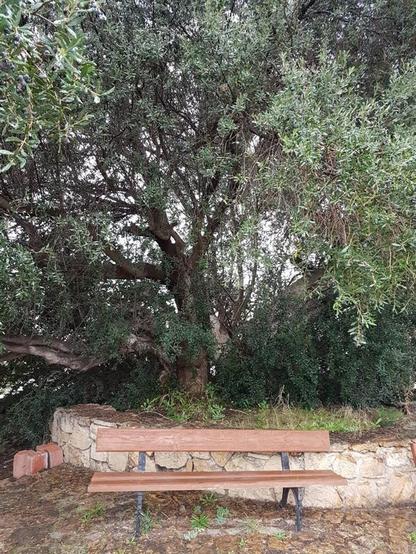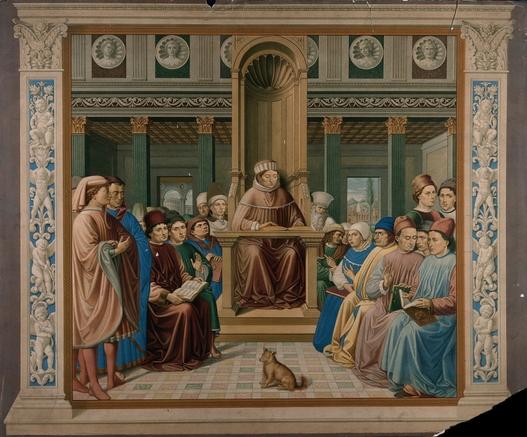Augustinus’ olijfboom
Wat opvalt bij het lezen van Augustinus is dit: hij was rusteloos op zoek naar de waarheid. Hij bekeerde zich dus eerst (na de lectuur van Cicero’s Hortensius) tot de filosofie, bekeerde zich tot het manicheïsme, bekeerde zich tot het christendom, bekeerde zich daarbinnen weer tot de variant die we nu orthodox noemen en vond geen rust. De polemieken rond het pelagianisme zijn niet de teksten van een man die tevreden is met wat hij heeft gevonden of heeft bereikt.
Hij was bereid voor de waarheid een hoge prijs te betalen. Hij had, in de keizerlijke residentie Milaan, een voorname positie aan het hof, stond op het punt zich in te trouwen in een vooraanstaande familie en mocht vooruitzien naar lucratieve betrekkingen in het rijksbestuur, toen hij ineens een punt zette achter die loopbaan en zich terugtrok. Augustinus was maar een venditor verborum geweest, een kletsmajoor. Het is alsof iemand die op het punt staat de Nobelprijs voor de Letteren te krijgen, concludeert dat literatuur eigenlijk maar prietpraat is, de Zweedse Academie adviseert naar de pomp te lopen en besluit de waarheid buiten de literatuur na te jagen. Dat Augustinus zoiets deed, illustreert zijn gedrevenheid.
Anders dan zijn tijdgenoot Synesios, die bijvoorbeeld geloofde dat onbestrafte moordenaars na hun dood bleven spoken, is er bij Augustinus weinig kleingelovigs te vinden. Hij sneed grote thema’s aan. De aard van de tijd. Het ontwikkelende ego. De rol van de overheid. Het verschijnsel wil. De herkomst van het kwaad. Alleen mensen maken onderscheid tussen goed en kwaad. Het is een van de dingen die hen maakt tot mensen.
Omdat Augustinus leefde in de late vierde eeuw na Chr., drukte hij zijn ideeën uit in de toenmalige vormentaal van het neoplatonisme en van het christendom. Dat is voor ons wat lastig te doorgronden. Soortgelijke dingen zijn te zeggen over de andere filosofen uit die tijd. Ook zij worstelden met de vraag waarom mensen het kwade konden doen. Dat leidde dan tot discussies over de aard van de ziel – bestond die uit een deel dat naar het goede en een deel dat naar het slechte streefde? Of had een mens soms twee zielen? De hermeneutische exercitie bestaat eruit dat we de eigenlijke gedachten om te zetten in onze eigen vormentaal. Leefde Augustinus in onze tijd, hij zou het hebben gehad over het reptielenbrein.
***
Op weg naar M’daourouch, het antieke Madauros, zijn we woensdag door Souk Ahras gekomen: het Thagaste waar Augustinus is geboren. Een druk, levendig, modern stadje. De heuvel in het stadscentrum moet in de Oudheid gedomineerd zijn geweest door een tempel; tegenwoordig zijn daar een oud mausoleum en een verveloze mairie. In de achtertuin daarvan staat een olijfboom – zie de foto hierboven – met meerdere stammen. Die staat bekend als l’olivier de Saint Augustin. Een bijzondere band met de bisschop is er vanzelfsprekend niet. Dit soort associaties zijn normaal in de volkscultuur, vergelijk Stonehenge en de tovenaar Merlijn.
Een tijdje geleden heeft, zo vertelt men hier, een Amerikaans lab onderzocht hoe oud de boom was en hij bleek maar liefst negenentwintig eeuwen oud te zijn. Dat Augustinus de boom, toen al eeuwenoud, heeft gezien, is aannemelijk, want zijn heidense vader zal hem wel eens hebben meegenomen naar die tempel op de heuvel. Maar meer valt er niet van te maken.
***
Er is een bordje met uitleg, geschreven in het Tamazight ofwel Berber. Een mooi voorbeeld van culturele reappropriatie.
#Algerije #Augustinus #bisschop #cultureleToeEigening #Numidië #olijfboom #pelagianisme #reptielenbrein #SoukAhras #Thagaste #ziel

